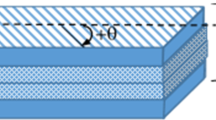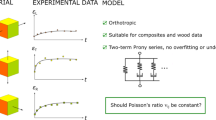Abstract
In this research project, creep and stress relaxation tests were run on angle- ply layups of a medium toughness graphite/epoxy system (Hexcel T3T145/F155). The creep and relaxation responses were represented with Maxwell/Kelvin- type models. Using a convolution integral and the Laplace transform method, a predictive creep response formulation was developed following a principle of virtual equilibrium state. Predictions of normalized creep compliance responses from short relaxation tests (based on a pseudo- elastic complementary approach) were compared to normal creep compliance values. As the fiber angles increased (moving farther away from the direction of the applied load), the difference between the compliances increased. This implies that, as toughness is increased, the accuracy of the pseudo- elastic method decreases. With the newer, tougher, resin systems, complementary approaches similar to the one used in this paper may be required.
Similar content being viewed by others
References
H. Krau, inCreep Analysis, John Wiley & Sons, New York, 6–17 (1980).
W. Callister, inMaterials Science and Engineering: An Introduction, 2nd ed., John Wiley & Sons, New York, 16–24 (1990).
J.D. Ferry, inViscoelastic Properties of Polymers, John Wiley & Sons, New York, 72–76 (1982).
W. Flugge, inViscoelasticity, Blaisdell Publishing Co., Waltham, MA, 23–31 (1967).
R.V. Churchill, inOperational Mathematics, McGraw-Hill, New York, 30–35 (1972).
A. Rivera-Dominguez, “Viscoelastic Characteristics of Graphite-Fibers Epoxy-Matrix Composite Laminates,“ Masters Thesis, Louisiana Technical University (1990).
W. Jordan, W. Bradley, and R. Moulton, Relating Resin Mechanical Properties to Composite Delamination Fracture Toughness,J. Composite Mater., 25(9), 923–943 (1989).
W. Jordan and W. Bradley, Micromechanisms of Fracture in Toughened Graphite Epoxy Laminates, inToughened Composites, ASTM Special Technical Publication 937, ASTM, Philadelphia, 95–114 (1987).
W. Jordan, “The Effect of Resin Toughness on the Delamination Fracture Behavior of Graphite Epoxy Composites,” Ph.D. Dissertation, Texas A&M University, College Station, TX (1985).
W. Bascom, R. Ting, R. Moulton, C. Riew, and A. Siebert, The Fracture of an Epoxy Polymer Containing Elastomeric Modifiers,J. Mater. Sci., 16,2657–2664 (1981).
Author information
Authors and Affiliations
Rights and permissions
About this article
Cite this article
Rivera-Dominguez, A., Jordan, W.M. Predictive creep response of linear viscoelastic graphite/epoxy composites using the laplace transform method. JMEP 1, 261–265 (1992). https://doi.org/10.1007/BF02648626
Issue Date:
DOI: https://doi.org/10.1007/BF02648626




